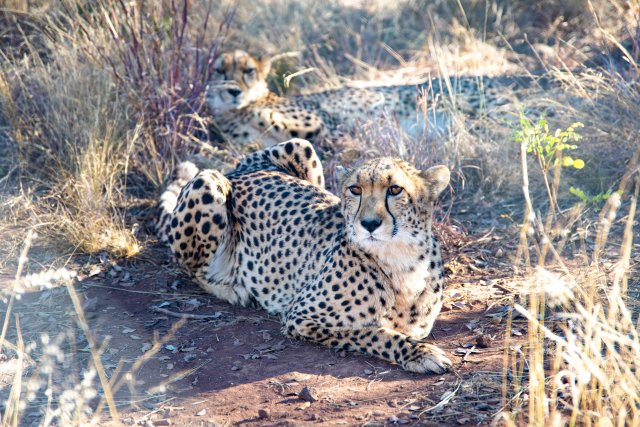6 Fascinating Facts About Cheetahs Living in Captivity
Facts About Cheetahs Living in Captivity
 When it comes to the animal kingdom, cheetahs are undoubtedly one of the most captivating creatures. Known for their incredible speed and striking appearance, cheetahs have long fascinated humans. While they are primarily found in the wild, there are also cheetahs living in captivity around the world. In this article, we will explore six fascinating facts about cheetahs living in captivity, shedding light on their behavior, conservation efforts, and the challenges they face.
When it comes to the animal kingdom, cheetahs are undoubtedly one of the most captivating creatures. Known for their incredible speed and striking appearance, cheetahs have long fascinated humans. While they are primarily found in the wild, there are also cheetahs living in captivity around the world. In this article, we will explore six fascinating facts about cheetahs living in captivity, shedding light on their behavior, conservation efforts, and the challenges they face.
1. Captive Breeding Programs
Cheetahs are listed as a vulnerable species by the International Union for Conservation of Nature (IUCN), with their population declining due to habitat loss, poaching, and human-wildlife conflict. To combat this decline, many zoos and conservation organizations have established captive breeding programs for cheetahs. These programs aim to increase the cheetah population and ensure genetic diversity.
For example, the Cheetah Conservation Fund (CCF) in Namibia has successfully bred cheetahs in captivity and reintroduced them into the wild. This not only helps in conserving the species but also provides valuable insights into their behavior and reproductive biology.
2. Behavioral Studies
Cheetahs living in captivity provide researchers with a unique opportunity to study their behavior up close. Observing cheetahs in controlled environments allows scientists to gain insights into their social structure, hunting techniques, and communication patterns.
One interesting study conducted at the Smithsonian Conservation Biology Institute found that cheetahs in captivity exhibit a higher level of sociality compared to their wild counterparts. They form stable social groups and engage in cooperative hunting behaviors, which are rarely observed in the wild. These findings challenge the notion that cheetahs are solitary animals and highlight the importance of studying them in captivity.
3. Education and Awareness
Cheetahs living in captivity play a crucial role in educating the public about the importance of conservation. Zoos and wildlife parks provide a platform for visitors to learn about cheetahs and their conservation status.
For instance, the San Diego Zoo Safari Park in California offers educational programs and interactive exhibits that allow visitors to understand the challenges faced by cheetahs in the wild. By raising awareness and fostering a connection between humans and cheetahs, these captive animals inspire people to take action and support conservation efforts.
4. Genetic Diversity
One of the major challenges faced by cheetahs in captivity is maintaining genetic diversity. Due to their low population numbers, cheetahs have a limited gene pool, which can lead to inbreeding and genetic abnormalities.
To address this issue, zoos and conservation organizations collaborate to ensure that cheetahs in captivity are genetically diverse. They carefully manage breeding programs and exchange animals between institutions to maintain a healthy and genetically robust population.
5. Veterinary Care and Research
Cheetahs living in captivity receive regular veterinary care, which allows researchers to study their health and well-being. This research not only benefits captive cheetahs but also contributes to the understanding of cheetah health in the wild.
For example, a study conducted at the Wildlife Safari in Oregon revealed that captive cheetahs are prone to certain health issues, such as chronic kidney disease and dental problems. These findings help veterinarians develop better healthcare strategies for both captive and wild cheetahs.
6. Conservation Challenges
While captivity offers several advantages for cheetahs, it also presents unique challenges. Cheetahs are highly specialized animals, adapted to wide-open spaces and high-speed chases. The confined spaces of captivity can lead to stress and behavioral issues.
Furthermore, the cost of maintaining cheetahs in captivity is high, requiring significant resources for their care, feeding, and medical needs. This poses a challenge for many conservation organizations and zoos, especially those operating on limited budgets.
Summary
Cheetahs living in captivity provide valuable insights into their behavior, contribute to conservation efforts, and help raise awareness about their plight in the wild. Captive breeding programs, behavioral studies, and educational initiatives all play a crucial role in ensuring the survival of this magnificent species.
However, it is important to address the challenges faced by cheetahs in captivity, such as maintaining genetic diversity and providing appropriate living conditions. By combining scientific research, conservation efforts, and public awareness, we can work towards a future where cheetahs thrive both in the wild and in captivity.
Read More About Cheetah’s From Wikipedia



